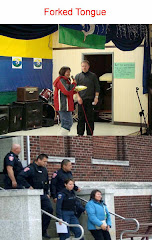© Indian Country Today May 05, 2008. All Rights Reserved
Posted: May 05, 2008
by: Kate Harries
Remembering oppression and resistance
CALEDONIA, Ontario - Recollections of oppression and resistance marked
the second anniversary of the police raid that failed to dislodge the
reclamation of Kanonhstaton, formerly the Douglas Creek Estates.
On April 20, 2006, Ontario Provincial Police officers armed with M-16
rifles, tear gas, pepper spray and stun guns launched a surprise
pre-dawn raid to eject a small band of activists.
''Our people were attacked by 400 fully armed Canadian police
officers,'' recalled Janie Jamieson, one of those who had moved in
three weeks earlier to stop a subdivision being built on land claimed
by Six Nations of the Grand River. ''Their attempt failed miserably.''
Hundreds of unarmed Six Nations residents poured out of the reserve and
forced the officers off the 98.8-acre property.
''This was a very monumental resistance,'' said Kahentinetha Horn, who
started Mohawk Nation News after the foiled OPP raid. ''This is a
worldwide issue; it hits a lot of indigenous people. How we did it,
it's being studied by a lot of people.''
''Today is about remembering what this is all about,'' Jamieson said.
She mentioned the KI-6, the six aboriginal leaders from
Kitchenuhmaykoosib Inninuwug who are serving six-month jail sentences
for their opposition to mining exploration on their northern Ontario
territory, and Mohawk warrior Trevor Miller, arrested in Minnesota in
early April.
Miller is now in prison facing charges related to a June 2006 incident
at Kanonhstaton for which he has already done time in Canada.
Jamieson paid tribute to resisters of the past, like Deskaheh, the
Cayuga chief and Longhouse League ambassador to the League of Nations,
whose international profile infuriated Canadian Prime Minister
Mackenzie King, prompting a 1924 attack on the traditional
Haudenosaunee (Iroquois) Confederacy government.
Among those who spoke during the day was elder Wilfred Jamieson, 95,
who was a child when the government, acting while Deskaheh was in
Geneva, deposed the confederacy chiefs and ordered elections under the
Indian Act.
''They sent the mounted police down, 50 or 60 of them,'' he said. ''I
wondered, 'What's going on? Why are they doing this? We've got our
treaty; it's signed by the English government.'''
In 1959, confederacy supporters marched on the Council House, built in
1864, three years before Canada became a country. The elected
councilors ran out the back door, Geronimo Henry, 72, told the crowd.
''We took the door off the hinges and all went in there,'' he said.
Rudy Longboat, who's now 75, was there that day and a week later, when
the police counterattacked and re-instated the elected council. ''At
night, these Mounties came in by twos. When they got to the front of
the building, they turned around and they started to club our people.''
Since then, the two systems of government have co-existed uneasily on
the Six Nations reserve. In March 2006, the confederacy chiefs came out
in support of the reclamation and, two weeks later, took their place at
the negotiating table with Canada for the first time since 1924.
Those negotiations continue, presently at an impasse over the amount of
compensation Canada is prepared to put forward. Six Nations values just
one claim resulting from land lost to flooding from the construction of
the Welland Canal at $1 billion. Canada has offered $26 million.
Six Nations was granted 900,000 acres, six miles on each side of the
Grand River, in 1784. The reserve encompasses 45,000 acres. Some 29
claims regarding stolen land and mismanaged funds have been filed at
various times.
The Ontario government purchased the Douglas Creek Estates from
developer Henco in June 2006. Three days before the two-year
anniversary, Conservative provincial legislator Toby Barrett questioned
Aboriginal Affairs Minister Michael Bryant, asking whether he had given
permission for the celebration.
''Some of my constituents are concerned that this type of event is
provocative and would renew tensions between various groups,'' Barrett
said.
Bryant rejected that notion.
Other speakers at the gathering, attended by about 50 people, included
former United Church minister Kevin Annett, who is secretary of a group
called the International Human Rights Tribunal into Genocide in Canada.
Annett recently released a list of 28 mass graves of aboriginal
children who died in residential schools from tuberculosis or ill
treatment. The list was compiled from the accounts of survivors who
witnessed the burials that often took place secretly, he said; and
since then, five more sites have been added to the list based on
information from people who have contacted him.
Annett called on authorities to investigate the sites.
The gathering also heard from Jobee, the aunt of Dudley George, the
Potawatomi activist shot by a police sniper at Ipperwash Provincial
Park.
Problems lie ahead, she said, because the provincial government is
making plans to return the former Stoney Point reserve - taken over for
use as an army base in 1942 - to the amalgamated Kettle and Stoney
Point band that was set up at that time.
That's not what George died for, Jobee said. ''That's not going to
happen.'' But such interference is typical of the way the government
pits nations against each other, she said.




